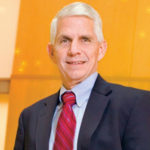How Can We Increase the HPV Vaccination Rate?
How Can We Increase the HPV Vaccination Rate? https://pediatricsnationwide.org/wp-content/themes/corpus/images/empty/thumbnail.jpg 150 150 Michael T. Brady, MD Michael T. Brady, MD https://pediatricsnationwide.org/wp-content/uploads/2021/03/Brady-crop.jpg- October 18, 2016
- Michael T. Brady, MD
Cancer is a terrifying diagnosis for a patient to receive or a doctor to give. So it would make sense that a vaccine proven to prevent cancer would be welcomed by everyone. The human papillomavirus (HPV) vaccine could prevent 28,500 HPV-related cancer cases – cervical, vaginal, vulvar, anal, rectal, penile and oropharyngeal – each year. The Centers of Disease Control and Prevention, along with the American Academy of Pediatrics, recommends the HPV vaccine series for every child at 11 or 12 years of age, though it can be started in 9-year-olds.
However, only 60% of eligible females and 42% of eligible males receive their first HPV vaccine dose; and only 40% of females and 21% of males complete the three-dose series. The annual incidence of HPV-related cancers has increased in the last decade. Why is a safe and effective cancer vaccine such a difficult to sell? What can we do to make it more acceptable?
We first have to understand why patients and families might struggle with the issue. The HPV vaccine can seem different from other vaccines. This is, after all, a cancer vaccine that also prevents a sexually transmitted disease. The three-dose series typically takes six months, and is intended for patients who often visit a pediatrician only for illnesses and sports physicals.
The public may be confused because the vaccine was initially licensed only for females. Traditional and social media have sometimes amplified misunderstandings and misinformation, including stories of adolescents who experience adverse events after the HPV vaccine (but were actually unrelated).
Then we have to address these concerns and misunderstandings thoughtfully. For parents worried that some adolescents may engage in sex sooner because they feel “protected,” studies show the vaccine has led to no acceleration of sexual activity in recipients.
We can also take a more proactive approach as physicians. The HPV vaccine has been recommended as part of the “adolescent platform” of vaccines. It’s possible to give the vaccines to children at 9 years of age, though, which may remove the immediate concerns about early sexual activity. And with a first dose at 9 years old, it’s more likely the entire course will be completed by the time of sexual debut.
For families concerned about safety, it’s important to point out that the three available versions of the HPV vaccine – HPV 2, HPV 4 and HPV 9 – only received approval from the U.S. Food and Drug Administration after large multinational studies. More than 80 million HPV vaccine doses were given through 2015, and no new safety concerns have been identified.
The most common adverse events are the same ones patients might experience with other shots: injection site discomfort and syncope. A 15-minute observation period after vaccination prevents significant syncope-related events. Reports to the federal Vaccine Adverse Event Reporting System have declined dramatically since 2008, and no serious adverse events have been reported in the last three years.
With more than 8 million doses given every year, it’s inevitable that some recipients will experience issues that are temporally related to the vaccine but are not caused by it. Traditional and social media have made anecdotal connections between the HPV vaccine and Guillain-Barre Syndrome, seizures, stroke, venous thromboembolism, appendicitis, anaphylaxis, autoimmune conditions, ovaria failure, postural orthostatic tachycardia syndrome or death.
The CDC, however, has found no increase in these conditions and events due to the HPV vaccine.
Effectiveness might be the easiest argument to make. The vaccines reduced HPV-associated precancerous lesions by 100%. HPV 4 and HPV 9 vaccines reduced genital warts by 97% in females and 89% in males. Surveillance has shown a dramatic public health benefit even with low immunization rates, including a 56% reduction in prevalence of four HPV strains in adolescent girls eligible for the HPV vaccine in the United States.
We also have to realize that we can do more to promote the HPV vaccine. There is evidence that at the regular 11-year-old visit, parents accept Tdap and meningococcal vaccines with minimal resistance, perhaps in part because of how confidently providers recommend them. Some providers are less comfortable with questions raised by the HPV vaccine and may be willing to delay the vaccine rather than have a potentially awkward conversation.
If we can prevent sexually transmitted infection and cancer, we need to prepare for those conversations. We should recommend the HPV vaccine as strongly as vaccines for Hib, measles, pneumococcal conjugate and other conditions. Sometimes it doesn’t feel this way, but patients and their families respect their pediatrician’s views on the value and necessity of vaccines. So there can be no equivocation from us.
Still, patients and parents may decline. We should use that opportunity to understand the factors that impact their decision. Asking questions may even allow pediatricians to counter their concerns. If nothing else, asking questions allows us to develop strategies for recommending the HPV vaccine to other patients. So consider offering the vaccine to children at 9-years-old. Know the statistics about safety and efficacy. Ask questions of those who decline.
With the HPV vaccine, we have an easy way to help many children and families. We should take advantage of it.
About the author
Michael T. Brady, MD, is associate medical director at Nationwide Children’s Hospital, co-medical director for Patient Safety, a member of the hospital’s Division of Infectious Diseases and a Professor of Pediatrics at The Ohio State University College of Medicine. An infectious disease specialist for more than three decades, Dr. Brady began focusing on the emerging HIV epidemic in the mid-1980s and its implications for infants, children and adolescents. He created the country’s first family-centered pediatric HIV program at Nationwide Children’s in 1987. While still involved with the HIV program, his interests in recent years have included promoting immunization in children, reducing healthcare associated infections and providing guidance on emerging infections.
Dr. Brady served as physician-in-chief at Nationwide Children’s from 2005 to 2013 and chair of the Department of Pediatrics at OSU’s College of Medicine from 2006 to 2013. Under his leadership, OSU’s Pediatrics faculty nearly doubled in size. Dr. Brady also oversaw the development of Physician Direct Connect at Nationwide Children’s, a service that puts community pediatricians in nearly immediate contact with specialists for consultations. He is a long-time member of Nationwide Children’s Graduate Medical Education Committee, influencing the training of the next generation of physicians.
At the national level, Dr. Brady has served as chair of the American Academy of Pediatrics’ Committee on Infectious Diseases. He is currently the associate editor of Red Book, the comprehensive infectious disease reference from the AAP. He is also a member of the editorial panel for Guidelines for the Prevention and Treatment of Opportunistic Infections in HIV-Exposed and HIV-Infected Children: Recommendations from the NIH, CDC, HIV Medicine Association, PIDS and AAP. Other activities have involved global immunization advocacy, ongoing education of pediatricians across the country and service on task forces handling issues ranging from circumcision to meningococcal vaccines.
-
Michael T. Brady, MDhttps://pediatricsnationwide.org/author/michael-t-brady-md/September 8, 2016
-
Michael T. Brady, MDhttps://pediatricsnationwide.org/author/michael-t-brady-md/
- Post Tags:
- General Pediatrics
- HPV
- Vaccines
- Posted In:
- Features
- Second Opinions







